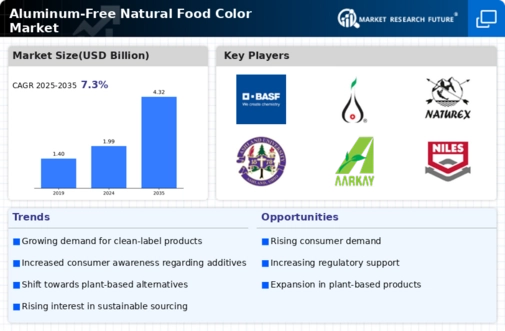Rising Health Consciousness
The Global Aluminum-Free Natural Food Color Market Industry is experiencing a surge in demand driven by increasing health consciousness among consumers. As individuals become more aware of the potential health risks associated with artificial additives, there is a notable shift towards natural alternatives. This trend is reflected in the projected market value of 1.99 USD Billion in 2024, indicating a robust consumer preference for products that are perceived as healthier. Companies are responding by reformulating their products to include aluminum-free natural colors, thereby aligning with consumer expectations and enhancing their market competitiveness.
Regulatory Support for Natural Ingredients
Regulatory bodies across various regions are increasingly endorsing the use of natural ingredients in food products, which significantly benefits the Global Aluminum-Free Natural Food Color Market Industry. Governments are implementing stricter regulations on artificial additives, prompting manufacturers to seek compliant alternatives. This regulatory environment not only fosters innovation but also encourages the adoption of aluminum-free natural colors. As a result, the market is expected to grow, with a projected value of 4.32 USD Billion by 2035, reflecting the positive impact of regulatory frameworks on consumer choices and industry practices.
Consumer Preference for Clean Label Products
There is a growing consumer preference for clean label products, which significantly influences the Global Aluminum-Free Natural Food Color Market Industry. Shoppers are increasingly scrutinizing ingredient lists, favoring products that are free from artificial additives and preservatives. This shift towards transparency in food labeling is compelling manufacturers to adopt aluminum-free natural colors to cater to this demand. As a result, brands that prioritize clean labeling are likely to gain a competitive edge, further propelling the market's growth trajectory in the coming years.
Expanding Application in Food and Beverage Sector
The Global Aluminum-Free Natural Food Color Market Industry is witnessing expanding applications across the food and beverage sector. Natural food colors are increasingly utilized in a variety of products, from snacks to beverages, as manufacturers strive to meet consumer demand for visually appealing and health-conscious options. This trend is likely to contribute to a compound annual growth rate (CAGR) of 7.31% from 2025 to 2035. The versatility of aluminum-free natural colors allows for their incorporation into diverse formulations, enhancing product attractiveness while adhering to health standards.
Innovations in Natural Color Extraction Technologies
Innovations in natural color extraction technologies are playing a pivotal role in the Global Aluminum-Free Natural Food Color Market Industry. Advances in extraction methods are enhancing the efficiency and cost-effectiveness of producing natural colors, making them more accessible to manufacturers. This technological progress not only improves the quality of natural colors but also expands their application range across various food products. As the industry embraces these innovations, it is poised for substantial growth, aligning with the increasing consumer demand for healthier and more natural food options.




















Leave a Comment